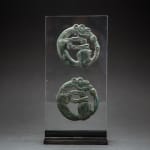Pair of Bronze Coiled Felines, 500 BCE - 400 BCE
Bronze
height 8.3 cm
height 3 1/4 in
height 3 1/4 in
FF.100
The Scythians were a semi-nomadic Central Asian group who originated in Iran but roamed across much of the Ukraine, Russia and the Pontic Steppe from about 1000 BC through the...
The Scythians were a semi-nomadic Central Asian group who originated in Iran but roamed across much of the Ukraine, Russia and the Pontic Steppe from about 1000 BC through the period of classical antiquity. They are known historically from Greek records, and archaeologically on the basis of their extravagantly ornate metalwork in burial mounds from above Greece all the way to Central Asia. They appear in the historical sources of other peoples – including the Assyrians, who they tried to invade in 770 BC, and the Persians, who tried to return the favour in 512 BC – but have left no written evidence of their own. Socially they are hard to assess, given the fairly mobile nature of their way of life, although there is epigraphic and graphic evidence of their appearance and some of their customs. Inevitably, their funeral behaviour is well understood, while much of their technology seems in fact to have been acquired or commissioned from settled communities. Their main period of prosperity was in the second half of the first millennium BC, fading away in the face of competition from the Sarmantians and the Celts, then attacks by the Goths, at the turn of the millennium.
Herodotus mentions a “Royal Dahae” which was the ruling elite of the Scythian forces, and which might well have existed if the riches of the burial mounds are any indication. Local governance was carried out by elites with control over local armies, who were sometimes hired out as mercenaries – especially archers – to more sedentary groups. They were by all accounts a martial and fierce people, much associated with noble barbarism, where women fought alongside men (seemingly with similar status) and both sexes were regularly tattooed with zoomorphic designs that also appear in their artwork. As a mobile way of life was not conducive to metalworking or other craft/art pursuits, most Scythian masterworks – of which there are an inordinate number – were designed by the Scythians but actually made by the Greeks. These include jewellery, horse harnesses and weapons, and include a large proportion of works in gold, which they highly valued and viewed as a status symbol. It is from the imagery on these items that the Scythians gain their glamorous if sanguineous reputation, although later works demonstrate that they had started to adopt Greek clothing and customs. Zoomorphic and anthropomorphic imagery abounds, combined with more mundane themes (milking cattle) and some geometric motifs.
Herodotus mentions a “Royal Dahae” which was the ruling elite of the Scythian forces, and which might well have existed if the riches of the burial mounds are any indication. Local governance was carried out by elites with control over local armies, who were sometimes hired out as mercenaries – especially archers – to more sedentary groups. They were by all accounts a martial and fierce people, much associated with noble barbarism, where women fought alongside men (seemingly with similar status) and both sexes were regularly tattooed with zoomorphic designs that also appear in their artwork. As a mobile way of life was not conducive to metalworking or other craft/art pursuits, most Scythian masterworks – of which there are an inordinate number – were designed by the Scythians but actually made by the Greeks. These include jewellery, horse harnesses and weapons, and include a large proportion of works in gold, which they highly valued and viewed as a status symbol. It is from the imagery on these items that the Scythians gain their glamorous if sanguineous reputation, although later works demonstrate that they had started to adopt Greek clothing and customs. Zoomorphic and anthropomorphic imagery abounds, combined with more mundane themes (milking cattle) and some geometric motifs.
8
of
8



